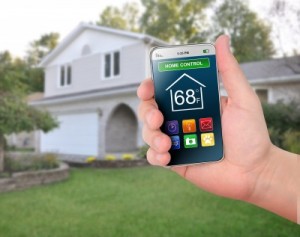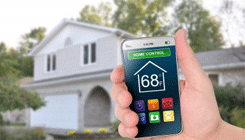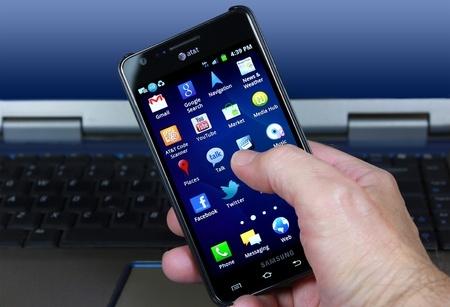 Today, WiFi-connected devices are popping up all over the place, both stand-alones and others connected to local networks. If you’re a mobile developer, you might want to expand your scope to include a decent awareness of current WiFi-enabled technology and how it's being used. For example, take the FitBits Aria WiFi smart scale. It measures your weight, tracks your percentage of body fat, and can accommodate up to eight users. It also uploads your data to a FitBits account via WiFi and your network, so you can record and watch your progress. Set-up is accomplished using a Windows computer connected to your local network. While the smart scale is interesting, it’s pretty tame compared to the Parrot 2.0 drone. This amazing piece of aeronautic/electronic/computer/software engineering has an on-board access point that you connect with via smartphone to control the craft and its flight profile. Not only can you fly the thing that way, you get a down-feed of what its cameras are seeing. You can also monitor important flight characteristics in real time. The flight computer is Linux-based and you have to ask yourself what kind of insane applications could you create to talk to the Parrot using your expertise in Android or iPhone development?
Today, WiFi-connected devices are popping up all over the place, both stand-alones and others connected to local networks. If you’re a mobile developer, you might want to expand your scope to include a decent awareness of current WiFi-enabled technology and how it's being used. For example, take the FitBits Aria WiFi smart scale. It measures your weight, tracks your percentage of body fat, and can accommodate up to eight users. It also uploads your data to a FitBits account via WiFi and your network, so you can record and watch your progress. Set-up is accomplished using a Windows computer connected to your local network. While the smart scale is interesting, it’s pretty tame compared to the Parrot 2.0 drone. This amazing piece of aeronautic/electronic/computer/software engineering has an on-board access point that you connect with via smartphone to control the craft and its flight profile. Not only can you fly the thing that way, you get a down-feed of what its cameras are seeing. You can also monitor important flight characteristics in real time. The flight computer is Linux-based and you have to ask yourself what kind of insane applications could you create to talk to the Parrot using your expertise in Android or iPhone development?
Wi-Fi Connectivity a Boon for Mobile Developers
We've adjusted our routers over WiFi for a long time. Boot up the router, select the access point, punch http://192.168.1.1 into the browser, enter the admin user name and password and you're in. What could be easier for the customer than filling out a few fields on a form and hitting Save? The cool thing is that you can get to your router interface using almost any WiFi-enabled device, from the lowly desktop and laptop all the way up through tablets and the latest smartphones. We take the process for granted.  Today, WiFi-connected devices are popping up all over the place, both stand-alones and others connected to local networks. If you’re a mobile developer, you might want to expand your scope to include a decent awareness of current WiFi-enabled technology and how it's being used. For example, take the FitBits Aria WiFi smart scale. It measures your weight, tracks your percentage of body fat, and can accommodate up to eight users. It also uploads your data to a FitBits account via WiFi and your network, so you can record and watch your progress. Set-up is accomplished using a Windows computer connected to your local network. While the smart scale is interesting, it’s pretty tame compared to the Parrot 2.0 drone. This amazing piece of aeronautic/electronic/computer/software engineering has an on-board access point that you connect with via smartphone to control the craft and its flight profile. Not only can you fly the thing that way, you get a down-feed of what its cameras are seeing. You can also monitor important flight characteristics in real time. The flight computer is Linux-based and you have to ask yourself what kind of insane applications could you create to talk to the Parrot using your expertise in Android or iPhone development?
Today, WiFi-connected devices are popping up all over the place, both stand-alones and others connected to local networks. If you’re a mobile developer, you might want to expand your scope to include a decent awareness of current WiFi-enabled technology and how it's being used. For example, take the FitBits Aria WiFi smart scale. It measures your weight, tracks your percentage of body fat, and can accommodate up to eight users. It also uploads your data to a FitBits account via WiFi and your network, so you can record and watch your progress. Set-up is accomplished using a Windows computer connected to your local network. While the smart scale is interesting, it’s pretty tame compared to the Parrot 2.0 drone. This amazing piece of aeronautic/electronic/computer/software engineering has an on-board access point that you connect with via smartphone to control the craft and its flight profile. Not only can you fly the thing that way, you get a down-feed of what its cameras are seeing. You can also monitor important flight characteristics in real time. The flight computer is Linux-based and you have to ask yourself what kind of insane applications could you create to talk to the Parrot using your expertise in Android or iPhone development?
 Today, WiFi-connected devices are popping up all over the place, both stand-alones and others connected to local networks. If you’re a mobile developer, you might want to expand your scope to include a decent awareness of current WiFi-enabled technology and how it's being used. For example, take the FitBits Aria WiFi smart scale. It measures your weight, tracks your percentage of body fat, and can accommodate up to eight users. It also uploads your data to a FitBits account via WiFi and your network, so you can record and watch your progress. Set-up is accomplished using a Windows computer connected to your local network. While the smart scale is interesting, it’s pretty tame compared to the Parrot 2.0 drone. This amazing piece of aeronautic/electronic/computer/software engineering has an on-board access point that you connect with via smartphone to control the craft and its flight profile. Not only can you fly the thing that way, you get a down-feed of what its cameras are seeing. You can also monitor important flight characteristics in real time. The flight computer is Linux-based and you have to ask yourself what kind of insane applications could you create to talk to the Parrot using your expertise in Android or iPhone development?
Today, WiFi-connected devices are popping up all over the place, both stand-alones and others connected to local networks. If you’re a mobile developer, you might want to expand your scope to include a decent awareness of current WiFi-enabled technology and how it's being used. For example, take the FitBits Aria WiFi smart scale. It measures your weight, tracks your percentage of body fat, and can accommodate up to eight users. It also uploads your data to a FitBits account via WiFi and your network, so you can record and watch your progress. Set-up is accomplished using a Windows computer connected to your local network. While the smart scale is interesting, it’s pretty tame compared to the Parrot 2.0 drone. This amazing piece of aeronautic/electronic/computer/software engineering has an on-board access point that you connect with via smartphone to control the craft and its flight profile. Not only can you fly the thing that way, you get a down-feed of what its cameras are seeing. You can also monitor important flight characteristics in real time. The flight computer is Linux-based and you have to ask yourself what kind of insane applications could you create to talk to the Parrot using your expertise in Android or iPhone development?


